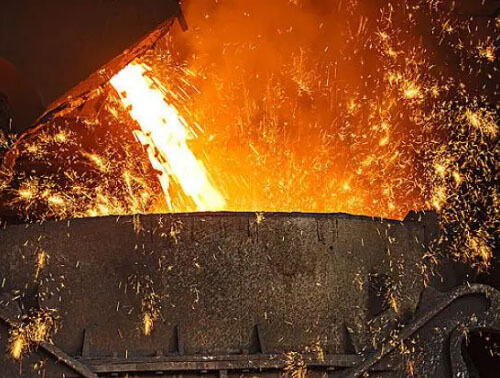
Sharing of high-temperature alloy smelting technology
Category:Company Dynamics | Date:2023-05-16
High temperature alloy materials are mainly used in key components of aviation and spacecraft, with high requirements for materials. In addition, high-temperature alloys have multiple components and contain a large amount of easily oxidizable elements, requiring very strict requirements for impurity elements and gas content. Therefore, when smelting high-temperature alloys, it is necessary to choose refined materials, that is, the content of sulfur, phosphorus, lead, tin, arsenic, antimony, bismuth, and gas in the raw materials should be low, and rust and oil free; Both raw materials and auxiliary materials must be baked to ensure low moisture content; It is also necessary to choose appropriate smelting processes to ensure the quality of materials.
In the 1930s to 1940s, high-temperature alloy materials were mostly produced using arc furnace or non vacuum induction furnace single melting, ordinary ingot casting processes. The advantages of this type of smelting process are large furnace melting batch, low equipment cost, relatively economic, good desulfurization effect of high alkaline slag, and the use of returned materials. However, the main drawback of atmospheric melting is that the alloy composition (especially some more active elements) is difficult to control due to burning loss; The gas content of the alloy is relatively high, and a large amount of deoxygenation products remain in the steel. The refractory material of the furnace lining and the steel barrel pollutes the alloy; During the pouring process, secondary oxidation also occurs, forming defects such as inclusions and bubbles in the steel. Therefore, this type of atmospheric single melting process has only been used in early low-grade high-temperature alloys (such as Chinese grades G112036, GH3030, GHll40, GH2132, etc.).
Since the 1950s, due to the development of aviation jet engines, high requirements have been placed on materials, and vacuum smelting technology has been widely used. The main characteristic of vacuum induction furnace smelting is that the smelting is carried out under vacuum, which can strictly control the active elements (such as aluminum, titanium, etc.) in the alloy. Vacuum smelting creates good degassing conditions, with low levels of hydrogen, oxygen, nitrogen, and inclusions in the alloy. Harmful impurities such as lead, bismuth, arsenic, and antimony can evaporate in vacuum, resulting in the purification of the alloy. GH4049, GHl51 (China) and other alloys have used this process. Vacuum induction furnace smelting also has shortcomings: crucibles are used during smelting, so refractory materials become a source of polluting alloys. Using ordinary ingot casting process, shrinkage and porosity of steel ingots are inevitable. The ingot crystallizes slowly during solidification, resulting in uneven crystal structure and composition inside the ingot. The crystal structure perpendicular to the surface of the ingot is not conducive to hot working.
In the early 1960s, the secondary remelting process was mostly used in the production of high-temperature alloy materials. The main secondary remelting equipment includes electroslag furnace and vacuum consumable furnace.
The secondary remelting processes include electroslag remelting and vacuum consumable remelting:
(1) High temperature alloy electroslag remelting. It refers to the secondary melting of electrodes cast in a single smelting process by using electric current to generate resistance heat through the slag layer. Due to the thin layer melting of metal electrodes, the contact area between metal droplets and slag is particularly large on the surface. The temperature of the molten pool can reach over 1800 ℃, ensuring strong interaction between the metal liquid and slag. The metal material is effectively refined, and gases, impurities, and non-metallic inclusions are removed in large quantities. Due to the water cooling effect of the crystallizer, the crystallization speed is fast and segregation is reduced. During the crystallization process, liquid metal is constantly replenished, eliminating the looseness in the center of the ingot and reducing the shrinkage at the head. Properly adjusting and controlling the smelting process can obtain columnar crystals from bottom to top along the axis, which can improve the hot working of ingots, which is particularly important for high temperature alloys that are difficult to deform.
(2) Vacuum consumable remelting of high-temperature alloys. It is to place the electrode from a single refining process as the negative electrode in a vacuum system, and use a water-cooled crystallizer as the positive electrode. Low voltage direct current is applied to melt the electrode using the heat released by the arc, achieving the goal of further refining. At the same time as the electrode melts, the molten metal crystallizes in a water-cooled crystallizer, becoming a remelted steel ingot. The purity of the remelted metal and the crystalline structure of the steel ingot are basically the same as those of the electroslag remelting process, but the degassing conditions for vacuum consumable remelting are better, and the uniformity of the composition of aluminum and titanium alloys is easily guaranteed. According to the equipment conditions and steel grade characteristics of the factory, there are various dual smelting combinations to form different process routes. GH3039, GH3044, GH4033, GH2132, and GH2135 alloys have used a dual process of electric arc furnace and vacuum white consumption furnace. GH2036, GH4033, GH2132, and GHll40 alloys have previously used a dual process of electric arc furnace and electroslag furnace. GH2135, GH4049, GH4037, and GH2130 alloys adopt a dual process of vacuum induction furnace and electroslag furnace. GH4133, G11698, GH220, and GH4169 alloys adopt a dual process of vacuum induction furnace and vacuum consumable furnace. Some technical conditions for high-temperature alloys stipulate that in the two processes of smelting the parent alloy and secondary remelting, there should be one process using vacuum smelting to reduce gas content.
(3) Others. In addition to the above smelting process, there is also suspension furnace smelting. Under vacuum, induction heating is used, and the furnace material does not come into contact with a specially made water-cooled copper crucible, suspended for melting and refining. Due to the lack of contact with refractory materials during the entire melting process, the purity of the alloy is particularly high. The aluminum and titanium elements in intermetallic compounds such as TiAl are very active and easily react with the refractory material of the crucible. Therefore, this process must be used for smelting. In addition, there are new processes such as electron beam furnace melting and plasma furnace melting. Use high-speed electrons or plasma to bombard the base material to generate heat for remelting. This type of melting process has a high vacuum degree and can effectively control the melting and crystallization processes, thus removing gases, inclusions, and harmful impurities is better than vacuum self consumption remelting. However, the high equipment and production costs, as well as the control of volatile elements, have not yet been fully resolved, make this type of process less commonly used in high-temperature alloys.

